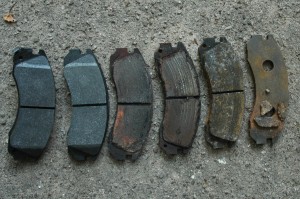While browsing the internet abyss formally known as Reddit, I stumbled upon a priceless post featuring pictures of store bought brake pads and their remains following a vicious trip around the track.
The owner of the pads, known as “driverdan” on Reddit, described the story of all the brake pads pictured and how they ended up in such bad condition, on the comment page of his post. This is what he said:
“This was after a driver’s ed at Watkins Glen. It was my first time with this car on the track. The pads I had on the car were supposed to be decent street and I brought a set of brand new “high” level street pads. The rotors were in good condition beforehand.
I completely killed the first set of pads in less than a day. They went down to bare metal on the track entering a corner which was quite scary. I had been checking them between runs and somehow they lost most of their material in the last run.
The second set “lasted” the rest of the event but were clearly overheating. I had to extend my braking zones to avoid completely cooking them. I didn’t have another set or extra rotors so I drove home on them not realizing how bad they were.
The rotors were completely destroyed. They were crumbling apart from the heat damage. The piece missing in the photo fell off while removing them from the car. The pads had material left on them but were also falling apart. They were supposedly rated for non-racing track use but they couldn’t hold up to the heat.”
As you can see from the picture, the pads on the far left are higher-end brakes, and the ones of the far right are the cheaper brakes. This picture is a testament to why having solid brake pads are so important. Even though the cheap ones are technically the same thing, that doesn’t mean they’re going to perform when you need them most.
Here are some tips to test the credibility of your brakes if you suspect they are not performing correctly:
- Make sure pedal is firm: Hold firm pressure on pedal for a few minutes, it should remain in position without sinking. If pedal falls toward floor, check system for fluid leaks. DO NOT drive vehicle if pedal does not stay firm or can be pushed to the floor with normal pressure.
- At very low speed (2-5 mph) apply brakes hard several times while turning steering from full left to full right, repeat several times. If you must, remove the wheels and check that components are not touching, rubbing, or leaking.
- Carefully examine all brake components, brake lines, and fittings for any possible leaks or interference.
- Make sure there is no interference with wheels or suspension components.
- Drive vehicle at low speed (15-20 mph) making moderate and hard stops. Brakes should feel normal and positive. Again check for leaks and interference.
- Always test vehicle in a safe place where there is no danger to (or from) other people or vehicles.
- Always wear seat belts and make use of all safety equipment.
